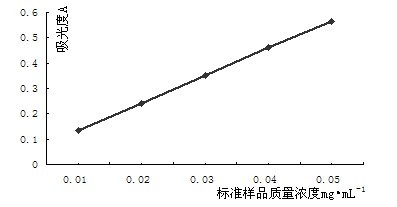Method for extracting celery flavone with stepwise enzymolysis method
The technology of celery flavonoids and step-by-step enzymes is applied in chemical instruments and methods, preparation of sugar derivatives, sugar derivatives, etc., and can solve the problems of large consumption of organic solvents or acid and alkali, complicated operation steps, residual organic solvents and the like, Achieve the effect of increasing added value, broad application prospects and extensive pharmacological activity
- Summary
- Abstract
- Description
- Claims
- Application Information
AI Technical Summary
Problems solved by technology
Method used
Image
Examples
Embodiment 1
[0029] Example 1: 1) Take fresh celery, wash, squeeze the juice, filter, take the supernatant and save it, and use the filter cake for later use; 2) Take 1000g of the filter cake obtained in step 1), add 1.1 times the weight of water, and stir for 10 minutes , after stirring evenly, add cellulase, corresponding enzymolysis conditions: enzyme amount 60Iu / ml, enzymolysis time 2h, pH 3.0, enzymolysis temperature 45°C; 3) Step 2) Add hemicellulase after enzymolysis Carry out the second enzymatic hydrolysis, corresponding enzymatic hydrolysis conditions: enzyme amount 40Iu / ml, enzymatic hydrolysis time 2h, pH 3.5, enzymatic hydrolysis temperature 55°C; 4) Step 3) After enzymatic hydrolysis, 80°C deactivated the enzyme, then filtered, and the filtrate Standby; 5) Mix the filtrate obtained in step 4) with the supernatant obtained in step 1), and freeze-dry; the conditions for freeze-drying are: -20°C, -30 Kp; 6.85g of acelery flavonoids are obtained.
Embodiment 2
[0030] Example 2: 1) Take fresh celery, wash, squeeze the juice, filter, take the supernatant and save it, and use the filter cake for later use; 2) Take 1000g of the filter cake obtained in step 1), add 1.0 times the weight of water, and stir for 7 minutes ;After stirring evenly, add cellulase, corresponding enzymatic hydrolysis conditions: enzyme amount 50Iu / ml, enzymolysis time 1.5h, pH 2.8, enzymolysis temperature 40°C; 3) Step 2) After enzymolysis, add hemicellulose Enzyme for the second enzymatic hydrolysis, corresponding enzymatic hydrolysis conditions: enzyme amount 30Iu / ml, enzymatic hydrolysis time 1.5h, pH 3.2, enzymatic hydrolysis temperature 50°C; 4) Step 3) After the end of enzymatic hydrolysis, extinguish the enzyme at 80°C, and then filter , and the filtrate for later use; 5) Mix the filtrate obtained in step 4) with the supernatant obtained in step 1), and freeze-dry. The freeze-drying conditions are: -25°C, -35 Kp to obtain 6.80 g of apioflavone.
Embodiment 3
[0031] Example 3: 1) Take fresh celery, wash, squeeze the juice, filter, take the supernatant and save it, and use the filter cake for later use; 2) Take 1000g of the filter cake obtained in step 1), add 1.1 times the weight of water, and stir for 8 minutes ;After stirring evenly, add cellulase, corresponding enzymatic hydrolysis conditions: enzyme amount 55Iu / ml, enzymolysis time 1.7h, pH 2.9, enzymolysis temperature 42°C; 3) Step 2) Add hemicellulose after enzymatic hydrolysis Enzyme for the second enzymatic hydrolysis, corresponding enzymatic hydrolysis conditions: enzyme amount 33Iu / ml, enzymatic hydrolysis time 1.6h, pH 3.3, enzymatic hydrolysis temperature 52°C; 4) Step 3) After enzymatic hydrolysis, extinguish the enzyme at 80°C, and then filter , the filtrate is set aside; 5) Take the filtrate obtained in step 4) and the supernatant obtained in step 1) and mix them, and freeze-dry them. The conditions for freeze-drying are: -22°C, -33Kp to obtain 6.78g of apioflavone. ...
PUM
 Login to View More
Login to View More Abstract
Description
Claims
Application Information
 Login to View More
Login to View More - R&D
- Intellectual Property
- Life Sciences
- Materials
- Tech Scout
- Unparalleled Data Quality
- Higher Quality Content
- 60% Fewer Hallucinations
Browse by: Latest US Patents, China's latest patents, Technical Efficacy Thesaurus, Application Domain, Technology Topic, Popular Technical Reports.
© 2025 PatSnap. All rights reserved.Legal|Privacy policy|Modern Slavery Act Transparency Statement|Sitemap|About US| Contact US: help@patsnap.com


